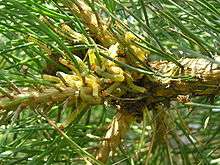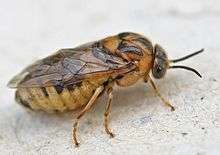Diprion pini
Diprion pini, the common pine sawfly, is a sawfly species in the genus Diprion. It is a serious pest of economic forestry, capable of defoliating large areas of pine forest. A major effect of the herbivore disturbance of the diprion pinis is climate change. Since it feeds until late in the autumn, affected trees are weakened and often die in the subsequent winter.[1] The species is found all across Europe, with outliers elsewhere. It affects the Scots pine, mountain pine, eastern white pine, radiata, Lodgepole pine and black pine. Scots pines are not generally killed by a single defoliation, but weakened trees may suffer increased attack by bark beetles, buprestid beetles, and pine weevils, which can kill trees, as can repeated defoliation. During high rates of defoliation, the growth rate of pines decreases significantly.[2]
 Mass of larvae on pine tree
Mass of larvae on pine tree Larval damage to pine
Larval damage to pine Last instar larva with exuviae
Last instar larva with exuviae.jpg) Larva forming cocoon in pine tree
Larva forming cocoon in pine tree.jpg) Opened cocoon
Opened cocoon Male imago
Male imago.jpg) Female imago
Female imago
| Common pine sawfly | |
|---|---|
 | |
| Female | |
| Scientific classification | |
| Kingdom: | |
| Phylum: | |
| Class: | |
| Order: | |
| Suborder: | |
| Superfamily: | |
| Family: | |
| Genus: | Diprion |
| Species: | D. pini |
| Binomial name | |
| Diprion pini (Linnaeus) 1758 | |
References
- Krokene, Paal (6 December 2014). "The common pine sawfly – a troublesome relative". Science Nordic. Archived from the original on 29 November 2016. Retrieved 28 November 2016.
- "common pine sawfly (Diprion pini)". Plantwise Knowledge Bank. Retrieved 28 November 2016.
3.^Perot, T., P. Vallet, and F. Archaux. 2013. Growth compensation in an oak–pine mixed forest following an outbreak of pine sawfly (Diprion pini). Forest of Ecology and Management 295:155-161.